The Zombie Cookbook That Lacked Enough Live Backers
by L.V. Anderson
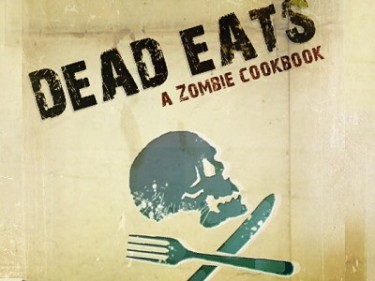
Sometimes, Kickstarter campaigns don’t meet their funding goals — but it’s not the end of the world! In this series we explore what happens next.
Freelance illustrator Gary Simpson began writing a zombie-themed cookbook called
Dead Eats in 2009. In the summer of 2010, he took his idea to Kickstarter, hoping to raise enough money to create a few prototypes of the book to send to literary agents and publishers. After 60 days, Gary had received pledges for only $745 of his $1000 goal. Here he talks about the experience and shares a recipe from the book.
L.V. Anderson: How did you get the idea for a zombie cookbook?
Gary Simpson: Well, the actual day that I had the idea, I was at the bookstore. I live in a small town in northern California, and they have one bookstore, and there was an entire wall devoted to cookbooks. I was picking up books left and right, checking them out, and there was an essential theme going on to them; each one started getting into a genre, almost. There was a bacon cookbook; there was one for vegetarians, vegans; how to cook like a restaurant chef and stuff like that. But they’re all still a little obscure. Looking at the ingredient list, it was like, you need this pickled pear and you need this type of white peppercorn, which you might not normally have in your pantry.
And there was one particular cookbook that really struck me, and it was a children’s cookbook; it was a Star Wars cookbook. It had these awesome pictures of cupcakes and cookies, and they had these little Star Wars figurines next to them. And the whole Star Wars theme was really detached from the actual food, but they gave them really clever names, like a Wookiee Cookie. These quirky little things that would interest a kid and possibly their parent to cook with them, and as I was going through it, I thought, “Nobody’s made a zombie cookbook.” Which, at the time, we were getting more and more saturated with zombies.
Did you intend this to be in any way an ironic commentary on the zombie phenomenon?
You know, I actually loved horror movies growing up, and it was kind of one of those — not so much counterculture, but not everybody was into it. And it is ironic, the fact that everybody seems to love zombies now. So yeah, the whole thing is wrapped up in a tongue-in-cheek presentation, like, well, if you’re interested in food and you’re interested in zombies, then there’s a zombie cookbook.
Did you write the whole cookbook before you did your Kickstarter?
I actually did. A lot of these recipes I knew in the back of my mind anyway. ’Cause my dad worked for a hotel chain, and he was a restaurant manager, and he had all these recipes that he passed on to me. And my grandmother was a big farm cook, always making these huge portions for everybody. She taught me a lot of things. And there was a point where right out of high school when I had to decide whether I wanted to do illustration and fine arts, or if I wanted to become a chef. I enjoy cooking on a personal level; I like being able to see people’s face when they’re eating it. So I decided not to be a chef. Since then, I’ve always been an experimental kind of cook, like, let’s try this ingredient with this and give it to friends and family and see how they react. I actually had a large database of food, recipes I had acquired. So yeah, I actually did write the entire thing first.
How would you describe the way that you cook?
A lot of these would now be considered comfort food. Now the Food Network’s basically telling us there are all these different types of cuisine, and a really big thing now is comfort food and slightly Southern cooking, and if anything it’s all in line with that. When I studied, it was underneath a French chef and later an Italian chef, so those traditional ways of making food carried over into making things like steaks, burgers, cornbread. You know, simple things that people would make at home, but in a kind of fancy way.
So tell me about some of the names of your recipes that evoke zombie-ness.
Well, there’s a Brain Stroganoff, which is similar to beef stroganoff, but in the actual appearance of it, in the end it actually looks like a brain on noodles.
How do you do that? How do you make it look like a brain?
Well, you take loose meat, which is basically any kind of ground meat. And you combine it with panko or bread crumbs, and cottage cheese or goat cheese.
Okay. That sounds disgusting. I mean, it sounds delicious, but it sounds like it looks disgusting.
Well, some of these things are supposed to be over the top, like you’d almost make it on a dare. Like you would with haggis, Scotch egg, something that’s like, “I can’t believe I just ate one of those,” or “I’m never going to touch that.” There are actually a number of people that it appeals to.
Tell me about the people that it appeals to. What kind of enthusiastic responses did you get? Or, on the other side, was anyone grossed out by this idea?
The gross-out factor was more that there was a couple of vegans that said, “Can you substitute something for this?” or whatever. But for most people, it was more the curiosity: What this is going to end up looking like, and what does it taste like? It changed people’s expectations. Everybody I talked to in person about it loved it. Like they wanted to see something from it. Which is great, which is kind of the whole point of it. Talking to people online, same thing. I contacted about thirty different literary agents, and within the first day, I got ten responses.
And there seemed like there was a lot of steam building up, and one of the literary agents told me that I should sit on it for about a year, because sales are down. The reason why you saw so many at the bookstores is the recession; people were trying to unload them. So at that point, after reaching out to see what literary agents might think of it, that’s when I got involved with Kickstarter to see what other people think about it.
What specifically were you trying to raise the money for? Was it to put together a more polished version of the cookbook?
Yeah. It was basically the final part in making a project. Something needs to be tangible. You can pitch an idea; you can give an elevator pitch or whatever, but people need to have something tangible in front of them before they can truly get 100% behind it. So the money was just going to get a finished product, print out a couple hundred of them, and send them off.
And so once you decided to start a Kickstarter, what kind of promotional stuff did you do?
Really, I didn’t do anything. I’d never tried Kickstarter before, and at the time it was still a young platform, so the very first month that I went into it, I really didn’t do that much to push it. I only put in a couple updates, I offered some stuff, but it was a pretty cold start, because I didn’t know what Kickstarter was going to do, if there was a platform to launch off of, or if Kickstarter internally would do stuff. I wanted to see where it would go.
What did you decide to do after your Kickstarter campaign was over?
I went back to the cookbook; I revisited it; I edited the hell out of it. It’s got three more coats of polish on it. And I still have it.
Do you have a literary agent now?
Not one signed on, no. I have a number of people interested, but I’m not ready to move forward.
Why not? Are you still waiting for the right moment?
In a sense, yeah. As far as marketing or promoting it, you do need to devote a portion of time to it, which unfortunately my work schedule right now doesn’t permit. I don’t have that much personal time anymore. And the zombie cookbook, I know that if I was going to devote time to it, I’d have to devote a lot. I just don’t have the time for it yet.
How do you envision it? If it’s something that comes to fruition someday, do you envision it being a full-color cookbook with photographs, or do you think that since you’re an illustrator you would draw illustrations for it?
The basic outlook of it would be a very kitschy Betty Crocker book, something from 1950s or ’60s, but re-visioned in a zombie apocalypse kind of way. There would be pictures, of course, just because I know personally people want to see that kind of stuff.
So true, yes.
But there’d be a lot of — people love information graphics, so it’d be like what part of a human body equates to what part of a chicken, like taste-wise. So there’d be information graphics detailing that, and we’ll take a cow and a pig. And there’s still a lot of introduction to it. I know being in the kitchen a lot, you shorthand things. Like what’s the difference between a pot and a pan? Or what’s a spatula? Surprisingly, a lot of people don’t know what these things are.
So you want it really to be a very educational, basic source.
Yeah. Like somebody who’s taking home economics in high school or middle school could even do this stuff.
Do you think cooking is something that people should do more?
I think cooking is very inspiring. It’s such a basic thing to want to make something, almost in a craft-like way. On a day-to-day basis, creatively, I have to do XYZ for a client, but I’m still inspired because I cook every day. Putting peanut butter on a hamburger; in some strange way that’s fulfilling and it’s refreshing, and I think that should appeal to a lot of people. They should want to learn how to cook. We gloss over these things when we’re growing up, like how to write a check, how to open up a bank account, how to cook, how to save money. Just odd things that seem like they should be fundamental.
Do you have any concern that the zombie moment is going to end before this cookbook gets produced?
Not particularly. It’s pretty much an industry at this point. It’s like saying there won’t be anymore vampire-slash-werewolf movies. They already found an audience; same for zombies. It’s not so much a genre anymore, it’s an actual industry. There are zombie snack foods now and zombie shampoo. It’s weird, but it’s an industry now.
A RECIPE FROM DEAD EATS
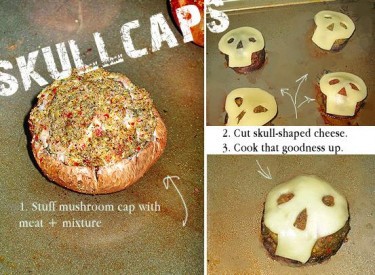
SKULLCAPS
4 large Portobello mushrooms, stems removed
½ lb “sausage”
4 strips of “bacon”
4 oz. cream cheese
4 drops hot sauce
4 tsp salsa
4 slices Provolone or Swiss cheese
2 tbsp Graveyard Herb
1. Preheat the oven to 425°F/220°C. Spray a baking sheet with nonstick spray.
2. Heat a skillet over medium-high heat and when hot, add bacon and cook on both sides till crisp. Remove bacon strips, and then crumble sausage into heated skillet, reducing heat to medium. Cook sausage for 10–12 minutes or till all pink is gone. Chop and crumble bacon strips into bacon bits into a mixing bowl. Add sausage, cream cheese, hot sauce, and Graveyard Herb until blended.
3. Place the mushrooms on the baking sheet, filling each cavity with the sausage mixture, mounding it slightly. Add a teaspoon of salsa to each mound and place in heated oven. Bake for 22–24 minutes.
4. Stack slices of cheese one on top of each other on a cutting board, with a sharp knife cut a skull shape into the cheese. Separate the cheese slices and place one skull-shaped cheese slice onto each mushroom. Cook mushrooms an additional minute in the oven. Serve hot.
GRAVEYARD HERB
Makes 16 tsp (the size of a normal bottle of seasoning).
2 tsp thyme
2 tsp oregano
2 tsp savory
2 tsp paprika (smoked preferred)
2 tsp celery salt
2 tsp basil (sweet preferred)
2 tsp sage
2 tsp rosemary
Previously: The Unfunded Art Project Inspired By Victorian Human Skulls and The Connie Converse Album That Never Got Crowd-Funded
Was your Kickstarter unsuccessful? Want to talk about it? Send us an email with a link to your Kickstarter page at kickstarted@theawl.com.
L. V. Anderson lives in Brooklyn and works at Slate. Images and recipes are copyright Gary Simpson.
Up Next: Nukes
“If a nuclear weapon was used in, say, New York City, and three, four or five hundred thousand people were killed, the American people would put overwhelming pressure on their government to make sure this couldn’t happen again. As a result, we would risk losing all our civil liberties. The Bill of Rights, the freedom of the press, the freedom of speech — all of that would probably quickly disappear as people insisted on a police-state kind of security.”
— And that’s the most upbeat part of this article.
Herman Cain's Most Magical Year Ever: A Photo Scrapbook
by Abe Sauer
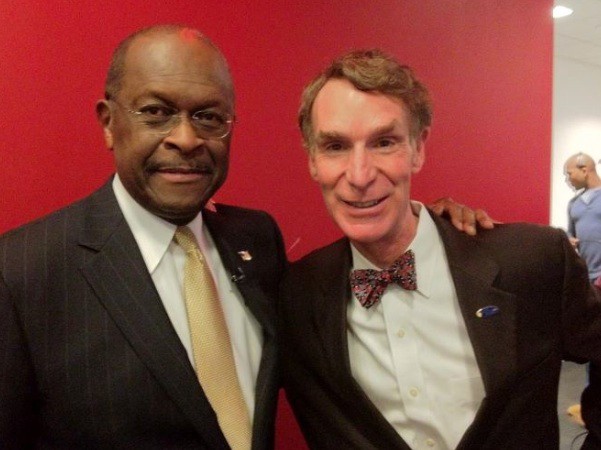
I met Bill Nye, the global warming guy.
Herman Cain went from “That guy who debated Clinton?” to candidate for the Republican nomination for president of the United States of America to frontrunner in that race to the “Cain Train!” to walking embarrassing quote machine to “Sexual Harassment Train” to “Whatever happened to that guy who debated Clinton and then ran for president?” That took place in about nine months.
But all was not lost. Along the way, Herman met a great gang of people. And as they say, what’s important is the journey, not the destination. Let’s look back on a scrapbook of Herman Cain’s two semesters spent studying abroad in Legitimacystan.
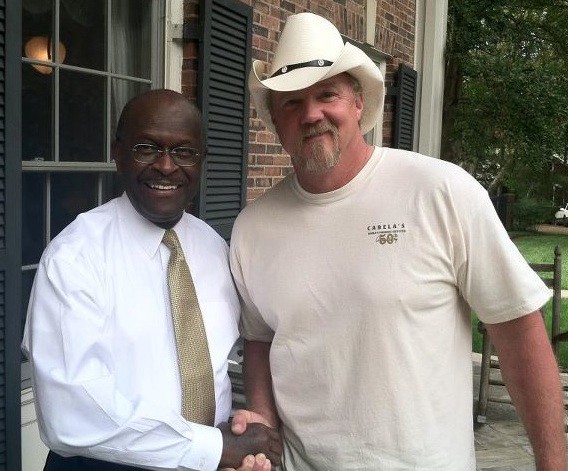
I was extremely honored to meet Trace Shelton.
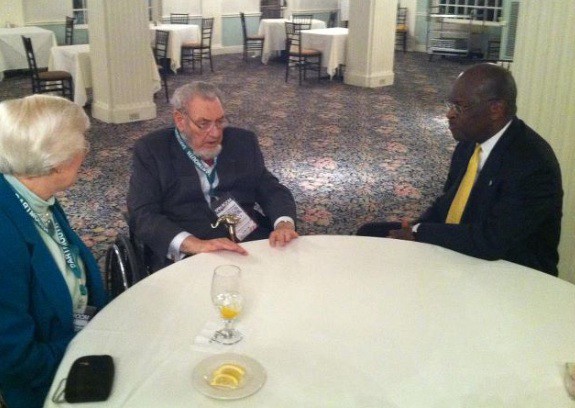
I promised I would pass along the esteemed former surgeon general C. Everett Koop’s concerns to my campaign manager.
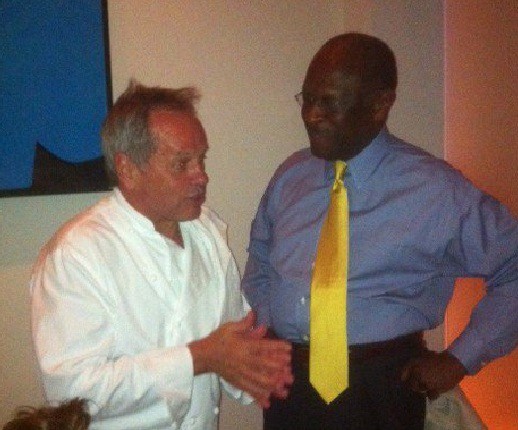
As I told Mr. Puck, the more toppings a man has on his pizza, the more manly he is. Wolfgang agreed and told me his restaurants definitely don’t serve any sissy pizzas.
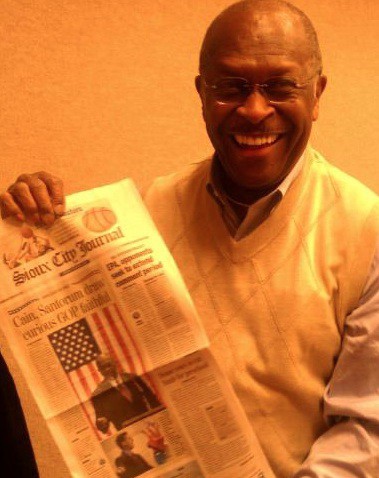
Now why on earth do newspapers keep getting skinnier while I keep getting chubbier? You can use that one!

I told President Bush my Anita Hill joke.
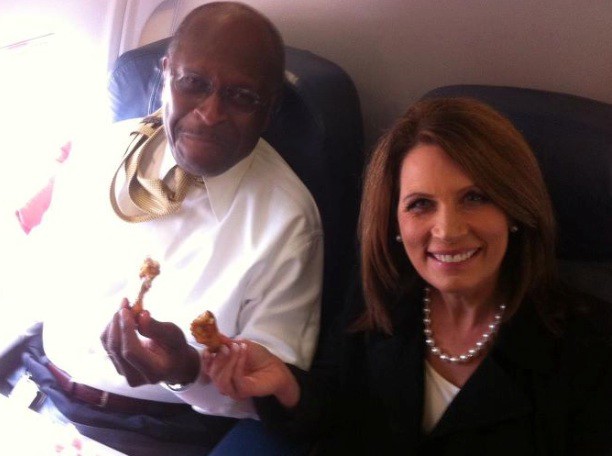
Congresswoman Bachmann taught me how to eat fried chicken on a plane.

This is my I.R.S. face. Hhhrrrrrmmmmmm.
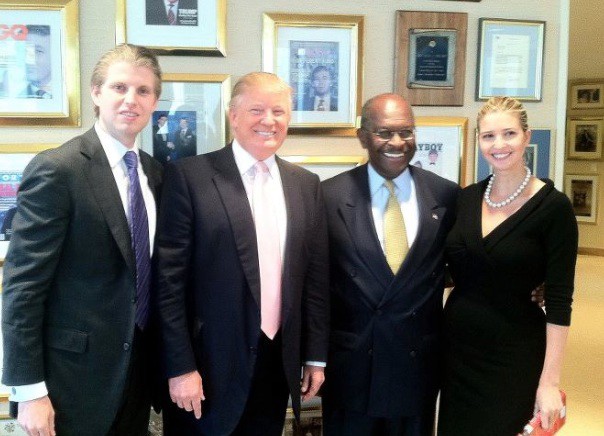
It didn’t occur to me until now, but “Trump” is an onomatopoeia.

Now that I’m out of the race I can say this: If Newt just pulled his pants up he wouldn’t look so hefty.
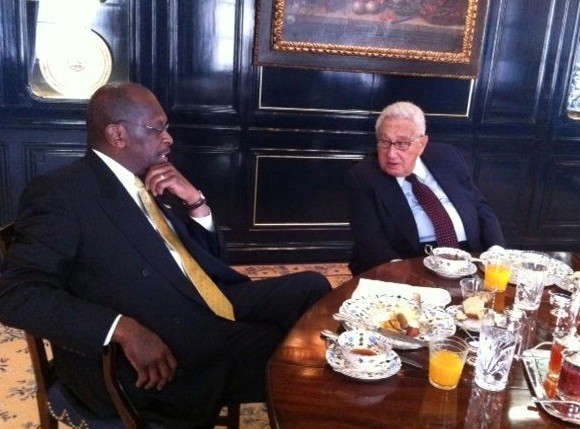
When I meet really smart people, I like to rest my chin in my hand, like how a sniper steadies his rifle. Because that’s what my mind is, a sniper rifle.

My detractors liked to paint me as a pawn of white conservatives. And then when I spend a whole afternoon with a black Iowan, the media looks the other way!
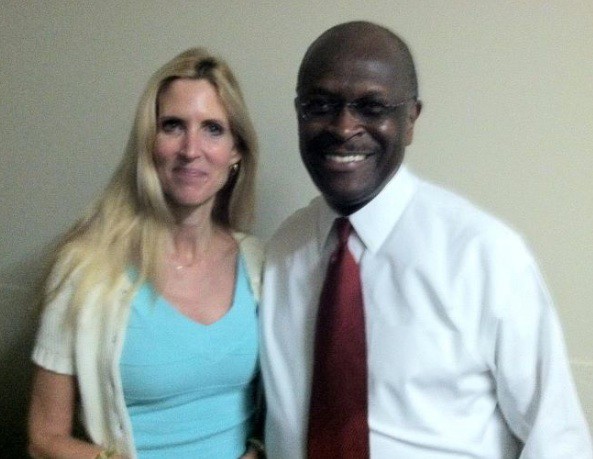
This nice woman kept coming to my events and bugging me for a photo. So, here it is.
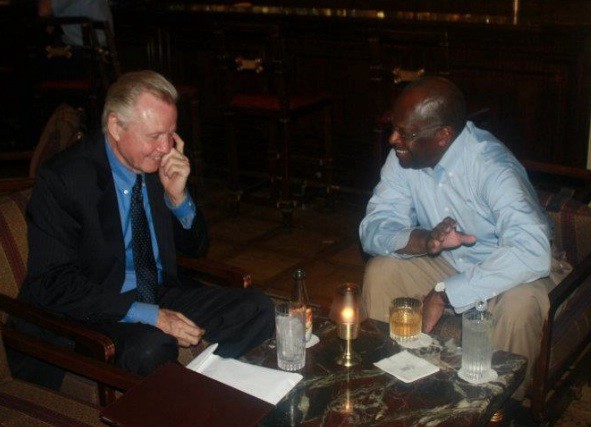
When you run into Jon Voight in Israel, you know the path He has chosen for you is right and justified.
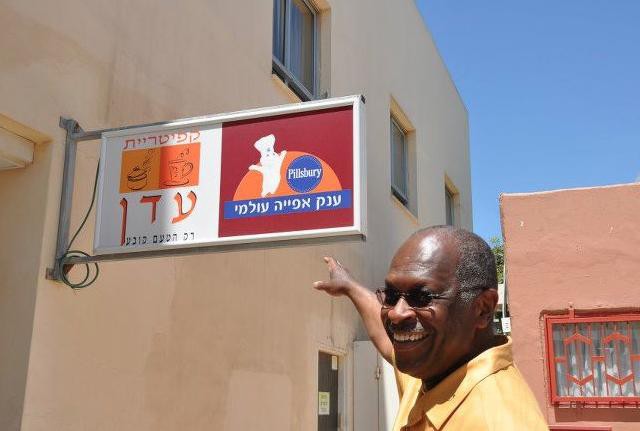
You know they’ve got Pillsbury in Israel? Crazy!
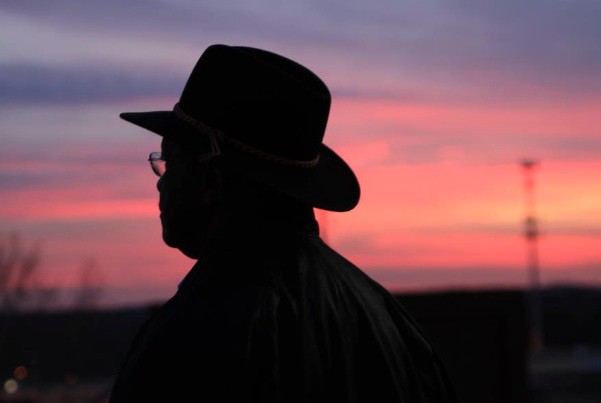
I don’t know what this crazy world has in store for me next. But whatever it is, I sure ticked a whole bunch of things off my bucket list this last year. You like the hat? I think I’m going to stick with the hat.
There are even more wonderful photos of this year on Herman Cain’s Facebook page.
Abe Sauer is the author of the book How to be: North Dakota. He is on Twitter. Email him at abesauer @ gmail.com.
Frenchman Disappointed By Moon
“I think our generation is obsessed with the moon. When we were children, we were told that in the year 2000 we’d be in spaceships and living on the moon. Nothing like that happened. We felt betrayed. Now people stay home in front of the screen. But when we were kids we were supposed to be out of our home, out in space. So I feel like when I make records, I keep the dream alive.”
— Stop keeping the dream alive, guy from Air. It’s an empty, useless dream.
Terrible Movie Still Terrible, But Now in 3D
by Regina Small

In honor of today’s 3D release of The Phantom Menace, Wired has re-released their 1999 review of that film, also in GLORIOUS, EPIC 3-D. Were we ever this young
How could George Lucas possibly botch the most anticipated film in history? Three words: annoying alien sidekick.
Say what you will about extremely rich man George Lucas… because he is extremely rich and will ignore what you say anyway.
Cooking Valentine's Dinner With A Kick From Champagne
Cooking Valentine’s Dinner With A Kick From Champagne
by Emerson Beyer
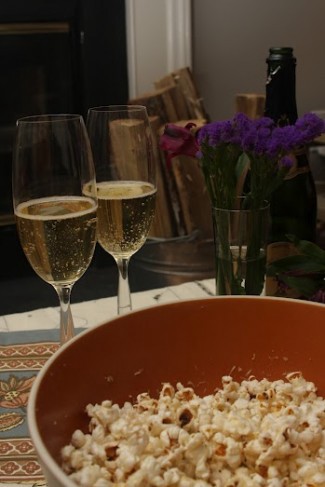
What makes Champagne so romantic? It may simply be that the form of intoxication associated with bubbles is uniquely titillating. Giddiness rather than wooziness. Champagne, the region, is at the 49th parallel, the same latitude as Vancouver’s, the northernmost extent of wine production. It may be that there is some sympathy between the grapes and us, owing to their endurance of the chilly and damp climate of northeast France and our own resolve to face down the February gloom with at least one evening of candle-lighted intimacy.
You could easily choose a Mediterranean wine for Valentine’s Day and fantasize an escape to the Riviera. But I for one prefer fireplace coziness while the wind blusters (and it just so happens that I have a half a case of bubbly left over from New Year’s Eve). We all know that going out on Valentine’s Day is a prix fixe nightmare, so here’s a delicious, fun, romantic, easy weeknight Valentine’s meal that you can make at home — with champagne as a main ingredient.
CHAMPAGNE VS. OTHER SPARKLING WINES
Cava and Prosecco are great replacements for Champagne as a festive aperitif, but they are not interchangeable with Champagne, especially in cooking, even though some Cavas and Proseccos are made in a way that intentionally duplicates Champagne. By contrast with the Spanish and Italian options, a great many of our domestic sparklers are made in the Champagne style and with the same varietals. As many of you know from experience (regret), the least expensive of these wines can tend toward the very sweet (and hangover-inducing), so that’s the thing to watch out for — make sure you get something that is dry and expresses the vinicultural and oenological values desired. I like Gruet from Albequerque, even though this completely sinks my Champagne-is-romantically-gloomy narrative. This wine is very authentic in its expression of Champagne wine making. It is produced by a Champenoise family with many generations of experience, and the New Mexico climate — cool but arid and thus discouraging rot — in some ways allows Gruet to reflect the Champagne character in an almost Platonic form. Drink enough of it and perhaps you could mistake the Rio Grande for the Marne.
You go to my head
And you linger like a haunting refrain
And I find you spinning ‘round in my brain
Like the bubbles in a glass of champagne
The Gruet Brut NV is in my opinion (among others) a go-to wine both for drinking and cooking. The bottle costs $15, and it has exactly the characteristics you want. It’s dry without being chalky, fruity but not sour, and sufficiently yeasty to serve for breakfast as suitably as a brioche.
There’s an enormous amount to know about Champagne and its impersonators, but the one thing I want to radically oversimplify for you here is the style classification you’re most likely to see on the label: Brut, Blanc de Blancs, Blanc de Noirs, or Sec/Demi-Sec. Champagne is traditionally (by European law, in fact) made from some combination of Pinot noir, Pinot meunier, and Chardonnay. “Brut” means generally that the wine is dry and that the Pinot noir and Chardonnay are present in almost equal amounts, with the Pinot meunier playing a supporting role. “Blanc de Blancs” means the wine is entirely or almost entirely Chardonnay. And “Blanc de Noirs” means the wine is entirely or almost entirely Pinot noir. “Sec” or “Demi-Sec” means the wine is sweet — fine for dessert or in cocktails. (FYI, Demi-Sec is sweeter than Sec, even though sec is French for dry. The word dry appears on many cheap wine labels meaning, oddly, oh so very sweet.) For cooking, I recommend using a Brut, which best encapsulates what the imagination might file under the category “Champagne.”
You may want to use the Gruet Brut NV for cooking, but choose a more special Champagne to drink. The big producers like Moët and Veuve may delight your palate and carry fond associations. However, a certain kind of snob (me) might point out that these productions aim for highly standardized products and maximum margins, so they are not necessarily great values. For less corporate consolidation and more idiosyncratic character, you can look for an unfamiliar label with the letters RM printed very finely on it, standing for récoltant-manipulant, meaning the wine is estate bottled — and then ask your wine merchant for specific pairing advice.
LOVE ALONE CAN’T MAKE TUESDAY INTO SATURDAY
A Valentine’s Day supper faces many constraints and challenges, particularly if it is to be a surprise. This year, we are looking at a Tuesday night, so preparation time should be kept low, and the amount of time left for, ahem, other pursuits should be maximized. The meal should be flavorful and satisfying but must not cause sleepiness, indigestion, gas, bloat or bad breath. It should be sensual, even carnal, but not carnivorous — you don’t want lamb sinew stuck between your teeth. Finally, you want to dirty the minimum amount of kitchenware so you don’t waste precious sexytimes cleaning the dishes.
Champagne pairs with a wonderfully wide range of ingredients. It’s discreet but also effectively scrubs the palate and tames stronger flavors. It’s terrific with smoky, unctuous, creamy and spicy food. It cuts through the oil of fried food, though you probably don’t want to do a lot of frying in Valentine’s Day.
I think a living-room “picnic” dinner for two at the coffee table, seated on pillows amid the glow of votives is suitably charming if corny. Play it up with an enormous bunch of pink carnations. The perfect menu should have a few small dishes that can be eaten with little silverware or risk of mess.
POP CORK, POP CORN
While you cook, have your sweetheart put on some music. Maybe you have a few prepared playlists ready to choose from? That was so thoughtful of you.
Pour a flute of Champagne for your companion to sip while snacking on a bowl of buttered popcorn with Parmesan grated over it. Popcorn made the traditional way on the stovetop (instructions will be found on the container) gives your home a very appetizing smell. I also read somewhere that microwave popcorn contains hideous chemicals, and even if that’s not true, it still produces an atrocious odor and a lot of unnecessary garbage. Making classic popcorn in the pan involves hot oil and steam — this is the mood we want.
A SILKY SAUCE FOR A SUGGESTIVE SHELLFISH
Oysters are justifiably associated with romantic meals. Eating a few can be filling without overstuffing. Eating them raw can cause certain scandalous sounds. They are bivalves, and this fact is somehow somewhat pornographic — go with it, just for tonight. A traditional condiment for raw oysters is mignonette, which consists of minced shallot (not enough to endanger your breath), coarsely ground white pepper, and Champagne vinegar or Champagne dosed with white wine vinegar or reduced Champagne (i.e., a cup simmered over medium heat until reduced by half.)
For a more sensual, less bitter, and showier alternative to mignonette, you could make a very simple Champagne sabayon. A sabayon is a simple custard. To dress up to a dozen oysters, use two egg yolks and two ounces of Champagne. Combine everything in a glass bowl with a hefty pinch of sea salt, and arrange this in a double boiler. Keep the water at a simmer, and stir the mixture determinedly for 15 minutes. You want it to get foamy and hot. Mmhmm, I went there. Serve this over raw oysters with a little caviar. (Whatever you can afford — I like flying fish.) Omitting the caviar, you could use this sabayon over raw, grilled, or roasted oysters topped with crispy lardons and tarragon leaves. (Vegetarian? Replace the oysters with roasted shiitake mushrooms.)
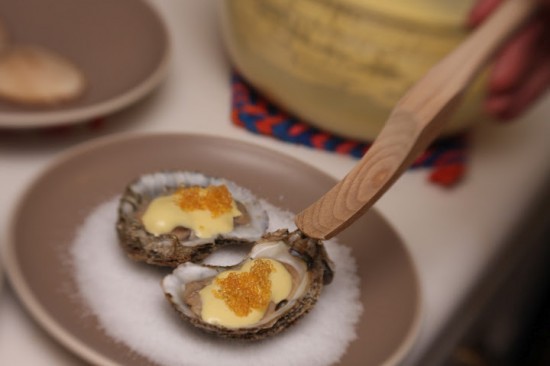
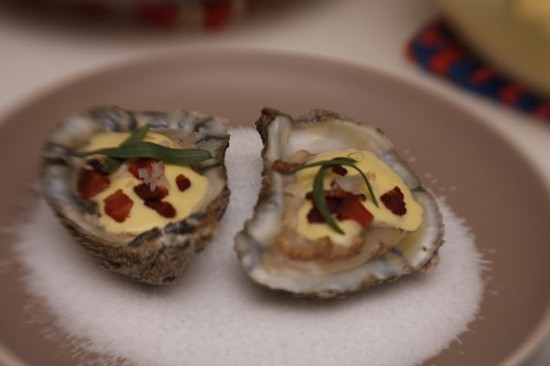
If you decide to make the Champagne sabayon, consider doubling the batch and reserving the egg whites. Once it’s cooked, remove half the finished sabayon for the oysters. Sweeten the remaining half with 1/4 cup of sugar or honey, and continue cooking over a simmer until everything is dissolved together. Remove that from the heat and set aside. Whip the egg whites with another 1/4 cup of sugar to soft peaks (or make a Swiss meringue
or whip two cups of heavy cream with two tablespoons of sugar). Combine the sweet sabayon with the egg whites or whipped cream, and you have a mousse! You can perfect this dessert by garnishing with some dark chocolate shavings.
BREAKFAST SERVED 24 HOURS
If oysters aren’t your “thing” (and I don’t want to hear your reasons because the word texture is a language peeve of mine), then how about serving “breakfast before bed?” The very height of romance! Champagne is a delicious companion to omelets, and you can make a fairly easy herbed Champagne cream sauce to pour over them. The sauce is a basic béchamel (remember how we do that?) that you flavor with an essence made by adding four tablespoons of chopped tarragon to a cup of Champagne and then reducing that mixture by 3/4 over medium heat. (Strain the cooked herbs from the liquid before adding it to the béchamel, then add an extra pinch of minced fresh herbs for color.) You can fill your omelets with something like asparagus, any shellfish (langoustine seems appropriately fancy), or duxelles (minced mushroom and shallot softened in butter).
Have we discussed omelets before? Everybody has a method, and I don’t want to discourage you from using your signature technique. If you want some advice, though, here’s how I do it:
• Pre-cook all fillings. An omelet takes a minute to cook, but asparagus needs five minutes. You can’t cook anything once it’s inside an omelet.
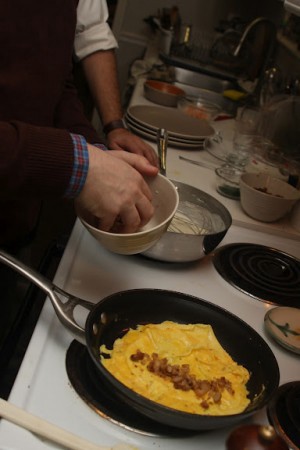
• Beat two eggs in a mixing bowl with a whisk. (For Valentine’s Day, you can simplify your work by making a four-egg omelet and sharing it — how cute is that?!) I don’t use any milk or cream.
• On a high flame, heat a small, lightweight frying pan and add a big spoonful of butter. Melt, foam, subside . . . you know the drill.
• Pour the eggs into the pan and lower the burner to medium. Let the eggs stand for 20 seconds or so while they begin to set up. Add salt and pepper.
• If you know how to flip an omelet, now is the time. Use two hands and be confident! If you don’t want to flip it, use a spatula to let the uncooked egg run around and underneath the already-cooked part. The main thing is to keep it moving, so that the results is delicate and yellow, not browned and chewy.
• Before it becomes overcooked — even while you’re still not sure the omelet is finished — remove it from the heat. Fill it along the center line, then fold the omelet over the filling. Put a lid on the pan, and let it rest for a minute or two to finish cooking the egg (and warming the filling) with just the heat from the pan.
Sticking with my too-clever “breakfast before bed” menu, how about doing French toast for dessert? It certainly works deliciously with Champagne, and you may already know how to make it: simply slice a baguette thick and on the bias; soak in a mixture of four eggs, a cup of cream, and two tablespoons sugar for about a minute, and then fry in a hot buttered pan. For a Champagne sauce, you could make a Crème Anglaise, which is relatively easy considering the delicious result, though you need an electric mixer. I use a simple, flawless Julia Child recipe:
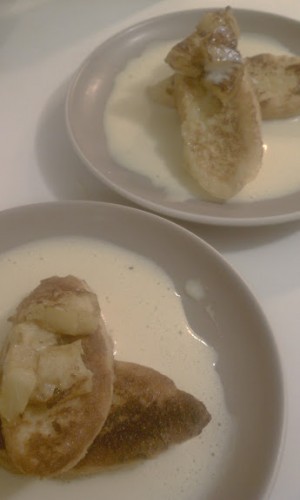
• Put 1–3/4 cup of whole milk in a glass measurer or bowl into the microwave. It will need to come to a boil, which generally takes around four minutes on full power.
• Put four egg yolks in the mixing bowl with 1/2 cup of sugar. Beat it on high speed until it is very thick — almost like warm taffy — and nearly white.
• Reduce the speed to low, and add the boiling milk very, very slowly. If the eggs get cooked too fast they will not form a nice sauce.
• Transfer the mixing bowl to a sauce pan and heat it over low heat for 15 minutes, stirring constantly with a wooden spoon. You can definitely do this while skilletting the French toast simultaneously. The sauce will get a bit thicker but not very thick — expect the consistency of cream. It’s cooked when it coats the spoon.
• Remove the sauce from the heat and give it a good beating with a wire whisk for two minutes while it cools. As you do so, add one teaspoon of vanilla and — for Valentine’s Day — a tablespoon of Champagne. I also tested this over the weekend with an inch of fresh ginger grated finely and added to the sauce, then I placed a slice of caramelized pineapple on top.
FOR THOSE NOT YET SATISFIED
If you want a meatier course, you could make miniature chicken or tuna “satays.” Do this by marinating strips of meat with ground cumin in peanut oil — place them in the refrigerator before leaving for work in the morning. Cook them by grilling or sautéing, and spear them on toothpicks. Make a sauce by using about a dozen dried apricots finely chopped, add a shot of Goldschlager (or a tablespoon of ground cinnamon), and cover them in a saucepan with Champagne. Simmer for at least 10 minutes until the apricots are nice and soft.
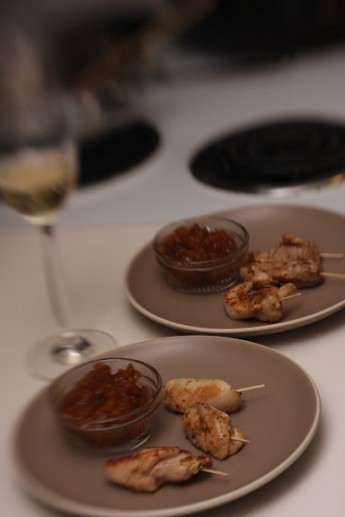
I did have one more outlandish idea over last weekend, and you’re welcome to try it if your disdain for “modernist cooking” is, like mine, masking a real envy. I made a blood orange mimosa jelly (1/3 cup Champagne; 2/3 cup blood orange juice, boiled; one packet of Knox unflavored gelatin; follow instructions on the package) and cut it into nigiri-sized rectangles upon which I placed slices of smoked salmon, then garnished with crème fraiche. Aside from preparing the jelly, which you’ll have to do in advance, this is a great surprise-dinner recipe because it depends not on technique but on gourmet groceries, including citrus at the peak of its season. The flavors balance very nicely, boosting and highlighting the Champagne’s latent tartness. Eating it with your fingers also feels rather naughty.
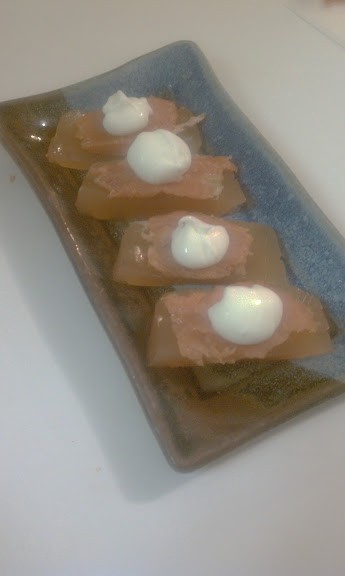
An appropriate Valentine’s Day gift might be a new pair of sunglasses to help your lover look intriguing and rakish rather than merely hung-over on Wednesday morning!
Previously: Cooking With Rum, Cooking With Tequila and Cooking With Bourbon
Related: How to Cook The Ideal Fourth Date Meal
K. Emerson Beyer, environmentalist and gadabout, lives in Durham, N.C. and tweets as @patebrisee. Photos by the author and Martin Solem.
Two Poems By Anthony Madrid
by Mark Bibbins, Editor
GOLDEN EAGLE AND A GOOEY PINK PEN
GOLDEN eagle and a gooey pink pen
Are just the thing on a cracker.
Every salt crystal has the potential
To grip like Michelin tire tread.
Helluva dancer, that gila monster.
Looks great in a cotton bodystocking.
But talking shop with the audience, she’s as
Uptight as a scolding nannygoat.
A nanomoment’s not nearly enough
To throw a tarp on a terrapin.
In therapy, you can come to terms
With the millipede’s indifference.
The millipede looked at his watch:
Mickey says hello. He has an
It, and you have an it, and the two its’
Names are Lefty and Chick Pea.
Chick Pea wrote a dialogue:
On the Nature of the Raj.
But Butter Rabbit and Camelopard
Are flying out from O’Hare.
The airport has many hazards: impassable
Rivers and starvey wolves.
Their hunting patterns exactly match
Those of the stranded octopus.
And who is as the suckblob?
And who knoweth the interpretation of the suck?
Daddy Longlegs looked it up
In the Lithuanian textbook.
But you’re the Delphic oracle, so say
What’s shorter than nothing at all? Goat o’ God
Sawed off a shotgun, gave
The stupid part to her kid.
I know, I know, I know.
Interrupted a hundred times,
The psyche goes into crisis.
And so: ineligible is the bat.
FOX CALLED AND SANK A SHOT
FOX called and sank a shot
Into the corner pocket
Of a diamond-eyed kangaroo, who
Looked better naked.
Turkeypig wrote a rockin’ review.
You’re welcome to click on the link.
But the comment stream is fulla trolls
And trotting out o’ credentials.
Here is something new:
I’ma answer it all with silence.
With silence, exile, cunning, I
Skillfully cut up cucumbers.
And as I crouch to pet this coil
Of orange extension cord, I think
Its mile-long flexible backbone
Is liquid metallic hydrogen.
And, oh, you know me all,
A plain blunt man that love my friend. I’m
Trying to put a nail in the wall
By hitting it with a mattress.
Anthony Madrid lives in Chicago. His first book, I Am Your Slave Now Do What I Say, will be published by Canarium Books this spring.
We know, we know, you can’t get enough poetry. The good news is there’s plenty more here.
You may contact the editor at poems@theawl.com.
A Photo History of Occupy Wall Street
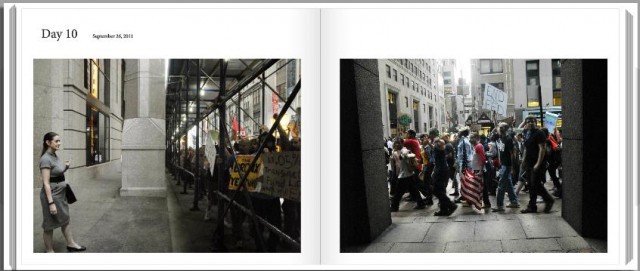
I would very much enjoy this book of photography by always-working photographer Stephanie Keith; it’s organized as a chronology of Occupy Wall Street. (To date. Obviously.) It is definitely… art-book priced. (Not cheap!) But that seems reasonable, also, for great documentation of a serious six-month project. Something for Valentine’s for the armchair radical in your life?
People From The Fake Past Talk Too Much Like Us
by Regina Small
Ben Zimmer, who writes a language column for the Boston Globe, has edited a series of clips featuring all of Downton Abbey’s various verbal anachronisms. (SPOILER ALERT FOR AMERICANS: This video contains some non-plot relevant bits from episodes 7 and 8, both of which will air in the U.S. on PBS this Sunday, February 12th. Of course, it’s possible that you are some kind of scofflaw and have already watched all of season two with some illegal Internet trickery. Shame on you, but yes, you can watch this video without fear.)
Zimmer’s written breakdown of the featured clips is here. (But he doesn’t even take up with the whole hamster debacle.) [Via.]
Restaurant Open On Valentine's Day
Keep your eye on WALB reporter Dayne Young. Sure, right now he’s just covering south Georgia, but one need only observe the effortless charm he exudes as he pulls off the most difficult of local news maneuvers in the middle of this report on Valentine’s Day dining at the Tifton Waffle House — suddenly, rather than just narrating the action, he’s part of it — to know that this kid is going places. You heard it here first.
